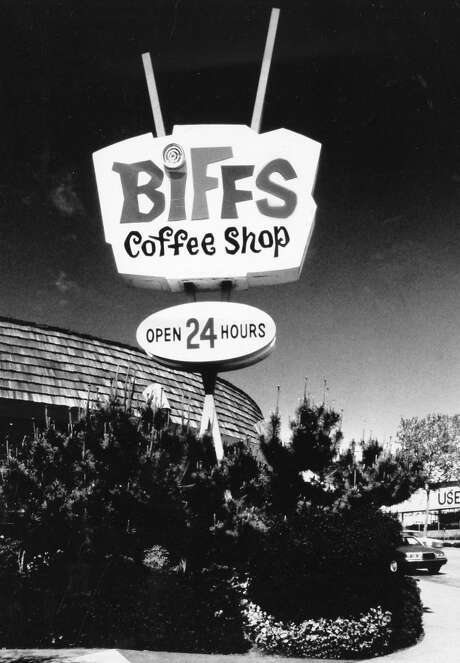Photo: Leah Millis, The Chronicle
To some, it’s a long-abandoned, unattractive relic of the 1960s: a circular block of concrete under a shingled roof.
To others, the Oakland building that housed the popular Biff’s Coffee Shop is a jewel, an example of the Googie-style — think big, curvy and Space Age — buildings that sprouted up in commercial strips in the ’50s and ’60s.
“You hear Mayor Libby Schaaf always talking about this ‘special sauce’ that Oakland has — well, Biff’s is an ingredient in her special sauce,” said longtime preservationist Joyce Roy, who feels a sentimental attachment to the old diner at the edge of downtown and Auto Row and would like to see its building saved.
But the now-boarded-up Biff’s faces imminent demolition to make way for a seven-story, 255-unit apartment building, which the Oakland Planning Commission will vote on Jan. 20.
It’s one of many old buildings that might be nibbled away as development transforms the city’s Broadway Valdez district, which spans the Broadway corridor between Grand Avenue and Interstate 580.
Roy, a retired architect who moved to Oakland in 1992, remembers the old Biff’s for its sparkly flying saucer roof, its Naugahyde seats and its waitresses who wore name tags that listed their home states.
In the Googie style
The restaurant was built in 1963 by Standard Oil — now Chevron — and designed by Armet Davis & Newlove, a Santa Monica architecture firm that specialized in what was called the Googie style.
“Googie buildings show the atmosphere of California post-World War II, which was about prosperity, growth and faith in technology,” said architect and historian Alan Hess.
He said the buildings, known for their large signs and geometric slants, were meant to be seen through car windows.
Decades later, many of those buildings are endangered. So are the car-oriented expressways where Googie once proliferated.
“Biff’s was built at a time when auto-centric eating establishments were popular,” said Rachel Flynn, head of Oakland’s Planning and Building Department. She compares the restaurant to a hulking object plunked in the middle of a field — a style of architecture that’s at cross purposes with the dense, walkable environment that city planners envision for Auto Row.
Biff’s closed in 1996, then sat empty at Broadway and 27th Street for years, covered in graffiti.
A building like that could survive for decades because it sat on the fringe of an area where businesses didn’t want to be. But after years of benign neglect, Oakland is booming. Last year, Uber announced plans to expand its headquarters to a former department store near the city’s center, bringing in up to 3,000 tech jobs.
Meanwhile, the nearby Auto Row corridor has become the fastest-growing neighborhood downtown, said Oakland Redevelopment Program Manager Patrick Lane. The seven-story high-rise at the Biff’s site, if approved, will be just one in a slew of projects expected to break ground this year. The City Council last week approved plans to add 234 apartments to two contiguous lots near the 19th Street BART Station. A Sprouts Market will open Wednesday at 30th Street and Broadway.
With business picking up in downtown Oakland and thousands of new residents expected to flock in, the need for housing outstrips the need to preserve decaying landmarks.
“The Broadway Valdez plan was envisioned to transform a sea of parking lots into a destination retail district,” said Scott Youdall, a partner at Hanover Co., the Texas firm that is pushing the plan to demolish Biff’s.
Youdall said his company considered restoring the old diner, or building around it, or incorporating the Googie facade into a new development. In the end, Youdall said, all of those ideas were too expensive to undertake.

Photo: Jerry Telfer, The Chronicle
In approving the Broadway Valdez plan, the City Council encouraged developers to preserve old architecture when it makes economic sense to do so. But the council also took into account that in some cases restoration might be too cumbersome and costly, and the architecture might not even be particularly beautiful.
Biff’s is one of those cases, Flynn said.
“The only Googie part left would be the shape,” she said. “There’s nothing unique there.”
Sweet memories
Even so, fans of Biff’s insist that Oakland is on the verge of destroying something precious.
“My children remember it very fondly as the place where you get hot chocolate on the way home from swimming lessons,” said Naomi Schiff, an outspoken member of the Oakland Heritage Alliance, a nonprofit dedicated to preserving historic architecture in Oakland.
Schiff said she is not opposed to Oakland’s efforts to build in empty lots, so long as the city retains elements of its past.
Rachel Swan is a San Francisco Chronicle staff writer. E-mail: [email protected] Twitter: @rachelswan































Recent Comments